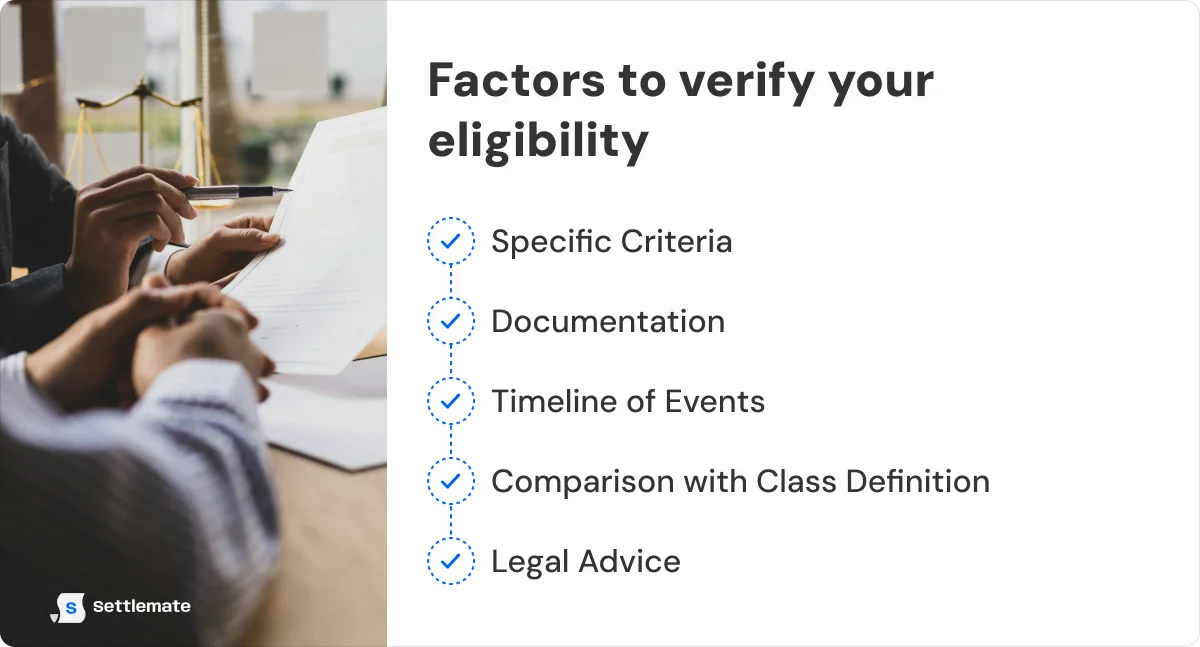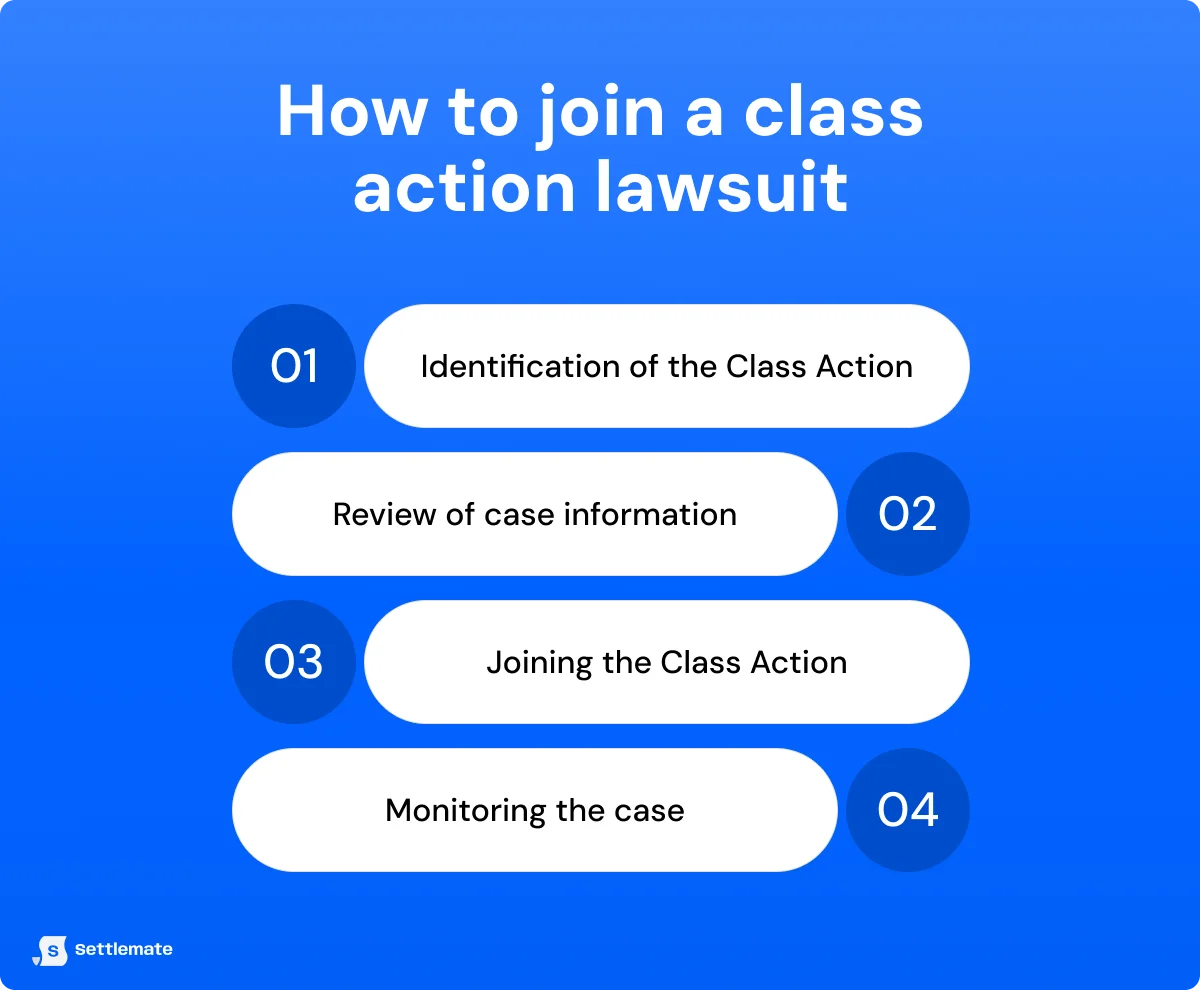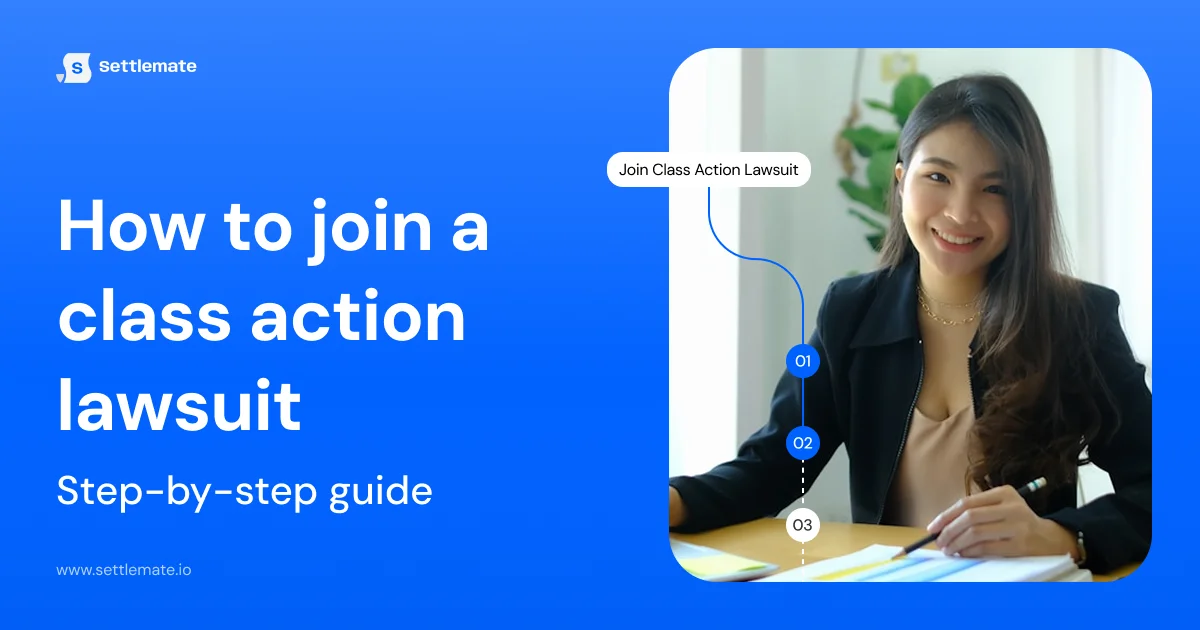You: "That email about a settlement looks legit, but do I really want to spend time figuring out how to join a class action lawsuit?"
Also, you: "If I ignore it, I could be walking away from money that's rightfully mine."
That's the dilemma most people face: act and risk getting tangled in legalese, or skip it and possibly lose compensation. The truth is that joining a class action isn't nearly as complicated as it sounds.
This guide will walk you through the process step by step. From verifying the notice and confirming eligibility to filing your claim and tracking the payout, you'll see exactly what to expect and how to protect your rights while saving time.
Quick checklist: join a class action in minutes
- Locate the official notice or site for the case
- Confirm eligibility by class definition and timeframe
- Calendar deadlines for claims and opt-outs
- Decide: stay in for a share, or opt out to pursue your own case
- Submit your claim with the required proof or declaration
- Track the case through final approval and distribution
- Use Settlemate to match, file, and monitor without the paperwork chase
What a class action lawsuit is and why it matters in 2026
A class action lawsuit allows a large group of people with the same issue, such as hidden bank fees, defective products, or data breaches, to bring one case to court together. Instead of thousands of individual claims that might be too small or too costly to pursue alone, a class action lawsuit consolidates them into one proceeding with a single result that applies to everyone in the group. In the United States, Federal Rule of Civil Procedure 23 governs these cases, establishing the standards for certification, notice, settlement approval, and attorney fees (Legal Information Institute).
In 2024, the combined value of the top ten class action settlements across all major liability areas reached $42 billion, marking the third consecutive year that aggregate large settlements passed the $40 billion mark.
For instance, in 2023, the Facebook privacy settlement paid out to more than 17 million claimants, with average checks ranging between $30 and $120. Other high-profile cases, such as the Equifax data breach, also demonstrated how millions of consumers can qualify without filing their own lawsuits.
Why it matters in 2026: class action lawsuits are increasing in both number and global reach. Consumer protection and privacy-related cases are becoming increasingly common, and regulators in other jurisdictions are expanding the scope of collective redress.
Understanding class action lawsuit rules
You do not need a law degree to follow along, but it helps to understand the basic guardrails that shape every class action lawsuit:
1. Certification requirements
Before a lawsuit can proceed as a class action, judges must confirm four key requirements:
- Numerosity: There are enough people affected to justify handling the claims together.
- Commonality: The group shares the same legal issue or set of facts.
- Typicality: The lead plaintiff's claim is representative of the group.
- Adequacy: The lead plaintiff and attorneys can reasonably protect the interests of all class members.
2. Opt-out versus opt-in
In the United States, courts treat most consumer class actions as opt-out, so they automatically include you unless you take steps to exclude yourself.
In many other countries, courts use opt-in systems, which require individuals to join actively. Some jurisdictions allow opt-out only in limited areas, such as those related to competition law.
3. Notices
Courts require the "best practicable" notice under the circumstances. Depending on the case, notices can arrive by mail, email, or even through digital ads if that is the most effective way to reach class members.
4. Settlement approval
Every class action settlement goes through judicial review to protect the interests of all class members. The judge holds a formal hearing, examines the terms of the agreement, and considers any objections raised by the class. Only after this process is complete does the court decide if the settlement is fair, reasonable, and adequate before approving.
5. Attorney fees
Lawyers are not paid directly by class members. Their fees come from the settlement fund or, as allowed by law, and the court must approve them. Fee motions are disclosed to the class so that members are aware of them before they are approved.
Keep these five points in mind, and the rest of the process will be much easier to follow.
Do you qualify? How to check eligibility quickly
Every class action lawsuit has strict boundaries that determine who is eligible to be part of the class. Courts set a class definition and a class period.

A typical definition might read: "All persons in the United States who purchased Product X between January 1, 2019, and December 31, 2022." If that statement describes you, then you are likely covered by the case.
In the Apple iPhone battery slowdown case, the class definition covered anyone in the U.S. who owned specific iPhone models purchased before December 21, 2017.
How to confirm eligibility:
- Read the official notice or settlement website: Courts require notices written in plain language that explain who qualifies, what rights you have, and what steps you must take. Each notice also directs you to an official settlement website, where you can review the full definition and claims instructions.
- Check your product, account, or timeframe: Match your situation against the class definition to ensure a correct match. Receipts, order confirmations, or account records are the most substantial proof; however, many settlements also accept sworn statements or alternative documents if the records are unavailable.
- Mark your deadlines: Class actions run on hard cutoffs. Claims, objections, and opt-outs all have specific dates set by the court. Missing one means you lose the chance to participate or to pursue your own case. Courts and administrators do not extend deadlines, so it pays to check them early.
- Use reliable tools to stay on track: Many people never claim money simply because they lose track of notices or miss deadlines. Trusted platforms and apps like Settlemate can alert you to open settlements, match you with cases you qualify for, and guide you through the submission process so you do not leave money unclaimed.
The step-by-step process to join a class action lawsuit
Joining a class action lawsuit in 2026 is simpler than most people think, but it still helps to know what to expect.

Here's the process laid out step by step so you can protect your rights and claim any payout that applies to you:
Step 1: Find or receive a valid notice
Class members usually learn about a case through a notice. Courts require administrators to use the "best practicable" method to reach as many affected people as possible.
That means you might get a notice in several forms:
- Mail: A postcard or letter delivered to your home.
- Email: An official message that contains case details and deadlines.
- Digital ads or social media: In some cases, courts approve online campaigns to ensure coverage when a direct customer list does not exist.
A valid notice will link to a settlement website and include the case name, court, deadlines, and instructions. If your email or postcard contains this information, you are most likely looking at a legitimate notice.
Pro tip: Search your inbox with the product or company name followed by "settlement notice." This often reveals emails you may have missed or overlooked.
Step 2: Read the notice closely
Do not skim the notice. Every line matters because it sets the boundaries of the case. Look for these key points:
- Who is included: The exact class definition, often tied to a purchase, subscription, or use of a product within a timeframe.
- What the case alleges: The legal claim, such as false advertising, privacy violations, or antitrust behavior.
- What you may receive: Settlement amounts, vouchers, or other benefits.
- How to file a claim: Instructions and links to online forms.
- How to opt out: The process if you prefer to pursue your own lawsuit.
- Key dates: Deadlines for filing claims, objections, and exclusions.
The federal judiciary requires settlement administrators to write notices in clear, accessible language and to make the claims process straightforward to understand. As a result, most notices are easier to understand than they initially appear.
Step 3: Decide to stay in or opt out
Once you understand the notice, you must make a choice.
- Stay in the class: You keep your right to a share of any settlement or judgment. When the court resolves the case, you give up the right to sue separately on the same issue.
- Opt out: You preserve your right to file your own lawsuit, but you give up the payout from the class action.
Courts and legal guides recommend opting out only if your losses are significantly higher than those of the average class member or if you wish to have complete control over your own case.
Rule of thumb: If your loss is small or your records are incomplete, staying in the class is usually the most practical decision.
Step 4: File your claim (when required)
Not all class actions require a claim form, but many do. Filing usually takes only a few minutes.
Typical requirements include:
- Your contact details
- Proof of eligibility, such as a receipt, account number, or serial number of a device
- A sworn statement if you lack receipts but still fall within the defined class period
Courts review distribution plans and favor digital submissions whenever possible. Therefore, most claimants file through an online portal, while others use mail-in options if necessary.
Step 5: Track the case and respond if asked
After you submit your claim, you may receive:
- A confirmation email from the settlement administrator
- Requests for additional documentation if there is a question about your eligibility
- Updates on hearings, objections, or appeals
The court holds a final approval hearing where a judge decides if the agreement is fair, reasonable, and adequate. This process can take months or even years, so patience is necessary.
Stay organized: Create a folder in your inbox or a calendar reminder for deadlines. Keeping track of notices ensures you do not miss updates.
Step 6: Receive your payout or benefit
If the court approves the settlement and resolves all appeals, the payout phase begins. Distribution can take different forms:
- Checks mailed to your address
- Prepaid debit cards
- Direct digital transfers, such as PayPal or bank deposits
- Non-cash benefits such as vouchers, extended warranties, or product replacements
Some cases use a flat-rate payout for everyone, while others use tiers based on proof submitted or purchase volume. All distributions must follow a court-approved plan, as outlined in Rule 23.
Step 7: If you have never received a notice but think you qualify
Not everyone receives a notice directly, even if they are eligible for the class.
If you suspect you qualify:
- Search online using the product name plus "class action settlement."
- Visit the official settlement website, which always includes the case name, court, and deadlines.
- Contact the settlement administrator. You can usually find their contact details on the court's order or on the official settlement website.
- Check trusted legal news outlets that track current settlements.
Timeline and typical pitfalls
Most class action lawsuits follow a predictable path: certification, notice, claims period, final approval hearing, and distribution, with appeals sometimes extending the process. Courts publish guidance to simplify notices and claims, but delays still occur.
Common mistakes to avoid:
- Missing deadlines: Every claim, objection, or opt-out request comes with a firm cutoff date. If you miss it, you lose your rights in the case.
- Trusting the wrong website: Always rely on the official settlement website linked in a court-approved notice. Random blogs, ads, or social posts can be misleading. Courts require administrators to use clear, verified URLs.
- Submitting incomplete documentation: If the plan requests proof, provide exactly what it accepts. Many programs allow alternatives, such as sworn declarations, when receipts are unavailable.
- Failing to update your contact information: Payouts may come months or even years later. If you move or change your email, notify the settlement administrator so you do not miss your payment.
The best way to join a class action lawsuit without the hassle
By now, you know the steps on how to join a class action lawsuit: check the notice, confirm eligibility, decide whether to stay in or opt out, file your claim, and track the case through to payout.
At first glance, the process looks simple. In practice, though, many people still miss out. Notices get buried in inboxes, deadlines pass unnoticed, and billions of dollars in settlement funds go unclaimed each year.
This is exactly where Settlemate steps in. Instead of digging through legal documents or worrying about missed emails, Settlemate does the heavy lifting:
- Smart matching: It identifies active settlements that match your purchases, subscriptions, or data breaches.
- Streamlined claims: It guides you through simple claim forms and avoids confusing legal jargon.
- Automatic updates: It keeps you informed with reminders about deadlines, claim status, and new settlements for which you may qualify.
- One-stop tracking: It organizes your claims so you never lose sight of pending payouts.
You do not need to learn court procedures, chase paperwork, or monitor settlement websites. Settlemate guarantees that the compensation companies set aside for consumers actually reaches the people it belongs to
Learn how to join a class action lawsuit and claim your share.
Download Settlemate from the App Store or Google Play and check the settlements waiting for you.









